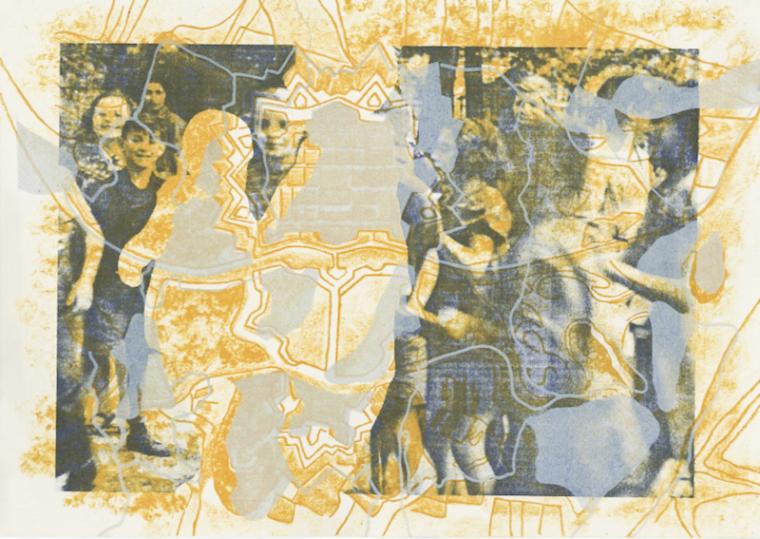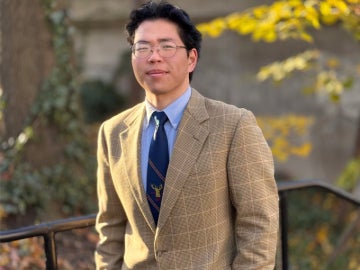Unbound Curiosity
May 12, 2016
Amanda Nagy

Reclaiming Space, photo and polyester lithography by studio art major Alice Shockey.
Photo credit: Courtesy of Alice Shockey
Fourth-year Alice Shockey, a studio art major, grew up hearing powerful stories about how her grandparents fled from Nazi invasions in the Holocaust.
Her grandmother Omi left Munich during Kristallnacht, and she would tell in vivid detail how she remembered seeing her local synagogue in flames on her way home from school. With both parents deceased, she had to look after her younger brother when they arrived in New York City.
Her grandfather Mitch left Nové Město, Czechoslovakia, on the children’s Red Cross train. His younger sister, Milada, was sick at the time, so his mother decided to stay in Nové Město with her. The two were deported shortly after Mitch’s departure and taken to Terezin transit camp. How they both came to perish in Auschwitz-Birkenau, Shockey learned in greater detail last year.
Her family’s history in the Holocaust has played a significant role in shaping her interests in the visible and invisible architectonic boundaries that define human existence. As a finalist in the 2016 Association of Independent Colleges and Universities of Ohio (AICUO) Awards for Excellence in the Visual Arts, her artist’s personal statement recounts the narrative of Milada and her mother, as well as Shockey’s own visit to Terezin transit camp in June 2015.
The Excellence in Visual Arts competition is judged by a panel of Ohio artists and members of the art community. Shockey was honored in a reception on April 26 at Otterbein University. Her art, as well as the work of the other finalists and winners, was featured in a walking exhibition as a part of Gallery Hop in the Short North District in Columbus on May 7.
Connecting geometry and Judaism
Shockey explains that it was during a semester abroad in Siena, Italy, when she began researching her family in Nové Město.
“In Siena, I was not only incredibly inspired by the architectonic space of this city, whose successive medieval walls visually revealed to me its rich history, but I was also very interested in engaging with the relationship between its unique demography and its architectonic boundaries. Siena has its own unique position in the Holocaust, and groups have historically been demarcated within the Sienese community, such as within the Jewish Ghetto tucked away behind Piazza del Campo—where attitudes still remain stigmatic to this very day.”
In March 2015, historian Vladimír Růžička responded in a letter to Shockey’s request about the fate of her relatives, Milada Hönigová, personal No. Dm 4772, and Zdeňka Hönigová, personal No. Dm 4771, who were murdered in Auschwitz concentration camp on September 6, 1943, after their deportation from Terezin.
Růžička’s thesis on the lives of the Jewish inhabitants of Nové Město and Metují, where he now works as the director of the public library, and where her grandfather Mitch grew up before his mother and sister were deported to Hradec Králové and then Terezin on December 21, 1942, can be found at the Masaryk University in Brno, Czech Republic.
Based on his research, which includes an account of one of few women who survived Auschwitz, Růžička learned that Milada, age 12, and her mother Zdeňka were separated from each other during the selection on the ramp after their arrival at Auschwitz on December 6, 1942. Milada was sent to the group of prisoners who were to be gassed in Bunker 2 at Auschwitz II-Birkenau, and her mother was sent to the group of prisoners selected for labor. However, Zdeňka decided to perish with her child, and she was able to join Milada in the line that led to Bunker 2.
With this newfound information, Shockey and her sister decided to visit Terezin and Nové Město immediately after her semester abroad ended. She was particularly moved by the thousands of drawings made by the children at Terezin between 1942 and 1944, even under brutal conditions.
“I found the names of both Milada and Zdeňka in the Memorial Exhibition Hall, which also showed more than 4,000 drawings that were made by the children at Terezin in the art classes led by Mrs. Friedl Dicker-Brandeis, former student of the Bauhaus-Universität Weimar. The art classes were meant to teach the children basic modes of observing their immediate space within the boundaries of Terezin, as well as expressing their own sensibilities of incarceration.”
A relationship with spaces
Shockey says the art at Terezin imparted new modalities of artistic language that further piqued her interest in demarcated spaces. “I went on to notice geometry of converging patterns within my prints Spaces in NYC, Crown Heights, Kingston Avenue Station, and many others. I began to study other modalities of geometry in Studies on Dissonance and Concordance, and in my installations and prints.”
She uses reproducible media as well as threads, twine, rope, paper, and wood to recreate urban spaces as prints and as installations. She says the material she uses acts as an intermediate between two-dimensional planes. The threads, twine, and ropes are to be drawn from their two-dimensional planes, to activate three-dimensional spaces.
“When I create installations and prints, I wonder about the relation between the architecture within urban spaces and the communities that interact within them. I wonder, how do these spaces impact their people and how do people recompose their cities?”
Shockey says she is grateful for the mentoring she has received from Professor of Studio Art Nanette Yannuzzi-Macias and Assistant Professor of Studio Art Kristina Paabus, both of whom have helped shape her as a student, an artist, and as a person.
“They have helped to no end by generously sharing with me the challenges they have confronted and persevered through in their own lives, and by guiding me not only artistically but in my own life, as I have also persisted through many challenges during my time at Oberlin.
“Since the day I met Nanette my second year at Oberlin, she has not only stood by me and defended me as an artist, but she has generously offered me her unconditional support as I have struggled with late stage Lyme disease throughout my education at Oberlin.”
Yannuzzi-Macias recalls meeting Shockey in her introductory sculpture course and immediately noticing her intellectual and creative curiosity in highly developed sculpture forms that always had a relationship to the spaces around them.
“I remember thinking, ‘This one thinks like an architect,’ and being very excited to have her in the department,” she says. “She has enormous drive. One thing we could always count on this past year was running into Ali still working after 11 p.m. in the Art Building. Once she locks into an idea there's no stopping her. She'll soon be examining it from numerous different perspectives from poetry to film to history to literature. And it doesn't stop there. That's the wonderful thing—once her research inquiries are satisfied, she's already discovered another thread and is wrestling with a whole new set of parameters.”
Shockey, who is from Princeton, New Jersey, will continue her artistic work after graduation with the summer residency Art Kibbutz on Governor’s Island in New York City.
“I hope to be surrounded by a vibrant community of artists, and I also hope to continue my studies on Judaism and on spatial geometry in relationship to the very unique history, demography, and location of the island.”
You may also like…
Learning by Teaching: Oberlin Students Share Global Music with Young Learners
College and Conservatory students in PACE 103 prepare local children for an immersive community concert at Oberlin.
Nuiko Wadden ’02 Joins Oberlin Conservatory Faculty as Assistant Professor of Harp
The versatile musician brings extensive opera, orchestral, and contemporary music experience to her role
Leo Hidy ’23 Earns 2026 Marshall Scholarship
Leo Hidy ’23, a comparative American studies major who also studied business and economics while at Oberlin, has received a 2026 Marshall Scholarship that will fund two years of graduate study in the UK.


